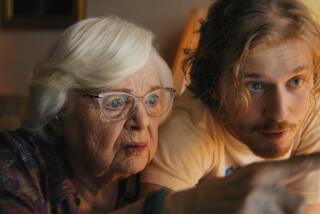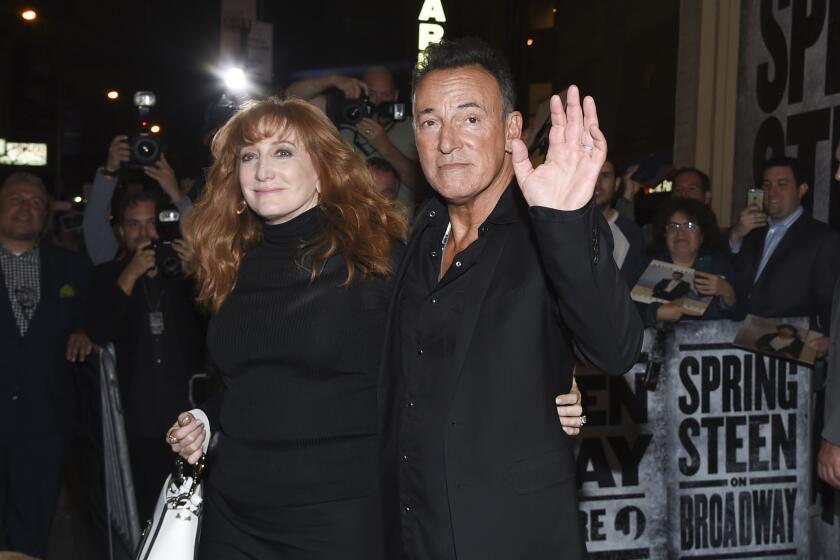MOVIE REVIEW : Branagh’s High-Wire Act
Kenneth Branagh remembers. And believes.
He remembers the old 1940s movies he saw on TV when he was growing up, glistening with glamour, menace and romance. And he believes in his ability to create a film to match the ones in his memory, and at the same time infuse it with a distinctly modern sensibility and a sense of fun. The result is “Dead Again” (citywide), a giddy whirling dervish of a movie that serves as a stylish and witty sonnet to the ghosts of Hollywood past.
An accomplished actor and director, Branagh is the closest thing to a modern theatrical/cinematic boy wonder since the days of Orson Welles and Laurence Olivier. Only 30 years old, he is considered one of Britain’s leading stage actors, and his 1989 film version of “Henry V” not only made an impact at the box office but also earned him a pair of Oscar nominations.
“Dead Again,” written by Scott Frank but spiritually sired by Alfred Hitchcock out of Shirley MacLaine, couldn’t be further from Shakespeare, and that seems to have been one of its attractions for Branagh and his wife, Emma Thompson, who co-star. Ready or not, this is the first New Age film noir, a past-lives thriller in which metaphysical questions about karma and fate play as important a role as motive and murder.
This may sound a bit far-fetched, but it is only the merest beginning. For “Dead Again” (rated R for language and violence) has an endlessly baroque plot rife with implausible coincidences and more corkscrew twists and heart-stopping turns than a treacherous coastal road in Italy.
The film’s inventive credit scene, for instance, contains enough plot elements to stock an entire movie all by itself. Garish newspaper headlines relate one of the shockers of 1949 Los Angeles, the murder of English concert pianist Margaret Strauss, the arrest of her German composer-conductor husband Roman, his conviction and his sentencing to death by a jury of his peers.
Next comes another brief vignette, a Death Row meeting between Strauss and Gray Baker (Andy Garcia), the newspaper reporter who’s covered his trial, shot in heavily shadowed Expressionistic black-and-white. “I loved my wife, I will love her forever,” Strauss says, a bit ominously. “This is all far from over.”
Then, suddenly, we are switched to the full-color present and the wrenching screams of a beautiful young woman (Emma Thompson). An amnesia victim who suffers from recurrent nightmares, she cannot speak but has for some reason dragged herself to the grounds of St. Audrey’s Home for Boys, which the film immediately lets us know was once the mansion where Margaret Strauss met her violent death.
Hoping to discover the sources of this woman’s pain, the school’s headmaster calls in a graduate of the school, now a quite grown-up private eye named Mike Church (Branagh) who (surprise!) specializes in finding missing persons. His search leads him to Franklyn Madson (Derek Jacobi), a mannered Melrose Avenue antique dealer who is an expert in regressing people into the past. He offers to help find out what’s troubling the woman, named Grace by Mike, in the hopes that her family will reward him once Grace’s identity is uncovered.
Of course, it turns out to be nowhere near that simple. As anyone who has noticed that Branagh played Roman Strauss in the opening scenes can figure out, the film will spend a good deal of time in the past, as Mike, Grace and Franklyn try to sort out the increasingly intricate connections between what was then and what is now.
Rather than being intimidated by this loopy scenario, Branagh has dived right in and invested it with the excitement he clearly feels for the material. He doesn’t flee from the excesses of genre, he embraces them passionately. He also embraces, as does Thompson, the challenges of playing two different roles with two different accents in two different time periods. And never one to be shy about things, he has made Mike Church something of a motormouth, so much the better to showcase his impeccable American accent.
And as a director, Branagh does much more than master the difficulties inherent in shooting two different films, one in color, the other in black and white. His sense of camera movement is clever and sophisticated, and he clearly is at home with actors, providing an ambience in which the entire cast, including Thompson, Jacobi (a brilliant stage actor best known on screen for “I, Claudius” and “Little Doritt”) and an unbilled, surprisingly sinister Robin Williams, get to flourish.
Best of all, Branagh has mastered the tricky high-wire act of simultaneously kidding the conventions he is being absolutely faithful to, allowing us to squeal with both fright and knowing laughter. His is a film lover’s film, gleefully packed with souvenirs of the past but not shackled or limited by them. Yes, they don’t make them quite the way they used to, but be grateful somebody is still making them like this.
‘Dead Again’
Kenneth Branagh: Roman Strauss/Mike Church
Andy Garcia: Gray Baker
Emma Thompson: Margaret Strauss/Grace
Robin Williams: Dr. Cozy Carlisle
Hanna Schygulla: Inga
Campbell Scott: Pete
A Mirage production, released by Paramount. Director Kenneth Branagh. Producers Lindsay Doran and Charles H. Maguire. Executive producer Sydney Pollack. Screenplay Scott Frank. Cinematographer Matthew F. Leonetti. Editor Peter E. Berger. Costumes Phyllis Dalton. Music Patrick Doyle. Production design Tim Harvey. Art director Sydney E. Litwack. Set designers Henry Alberti, Joseph Hubbard, Eric Orbom. Set decorator Jerry Adams. Running time: 1 hour, 47 minutes.
MPAA-rated R (language and violence).
More to Read
Only good movies
Get the Indie Focus newsletter, Mark Olsen's weekly guide to the world of cinema.
You may occasionally receive promotional content from the Los Angeles Times.











